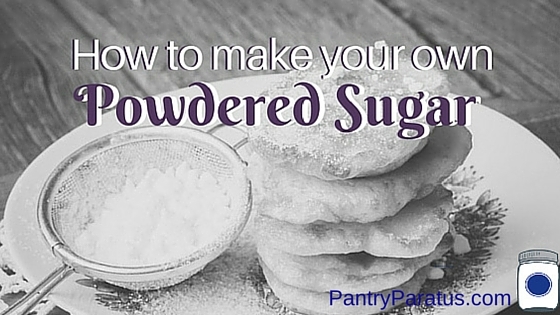
Powdered sugar makes nearly everything better.
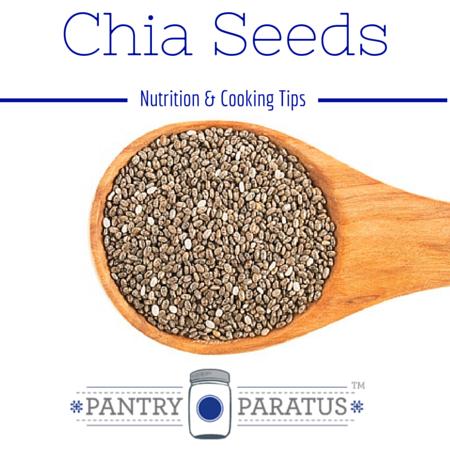
I am a traditionalist in most things, including food; I rarely jump on a bandwagon for the newest healthy thing out there, because most of it is bunk. But then, in our modern age, many of us are still discovering the traditional foods that other people groups have been eating for centuries. Such is the case with chia seeds. This nutty, delicious seed spiked in popularity about a year or so ago and is now falling into the shadows of the latest-coolness; but I do not consider it a “bandwagon” at all—rather, we were all a bit late to the party and shouldn’t make an exit too soon.
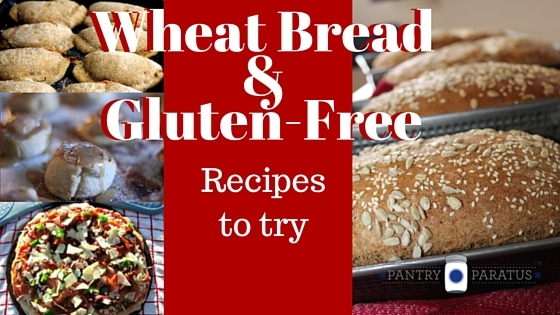
Pantry Paratus knows bread; it is probably what we do best! In fact, if you sign up for our newsletter, you get a half-hour bread baking tutorial video in your inbox (in about 24 hours). If you are new to baking or to baking with home-milled flour, that video is a great place to start! Below, we share some of our favorite Pantry Paratus recipes, but below that you will find some other excellent wheat bread and gluten-free bread recipes.
Continue reading Wheat Bread & Gluten-Free Bread Recipes You Must Try
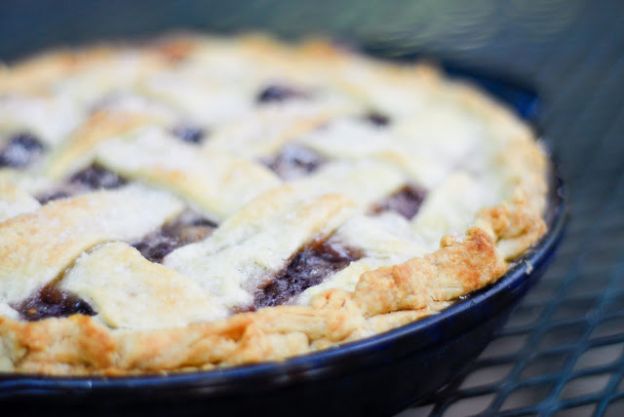
You know that you are supposed to eat your dinner first. But why not have pie twice? Let’s start with some delicious savory pies to warm you inside & out.
Reformation Acres give you a recipe that tastes like Great Grandma’s–she shows you how to use lard and to decrease the sugar so that it is truly wholesome and delicious.
Let Pantry Paratus make a few recommendations for a perfect crust, too: Pie Weights will give you an evenly baked and flat bottom crust. The ceramic pie bird dates back to Victorian times. It releases steam so that your pie will not bubble over, but will cook evenly instead.
If you are looking for a flaky crust and even the ability to make this traditional comfort food gluten-free, then check out this recipe by Laurie from Common Sense Homesteading. She nailed it!
Beef & Bok Choy
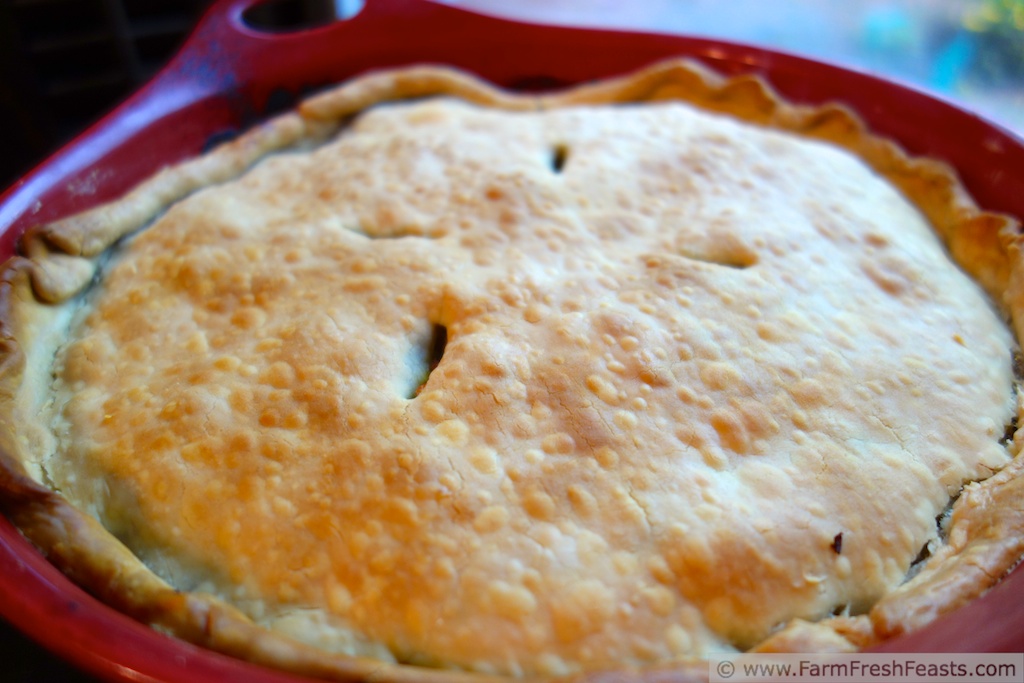
Chunky meat and vitamin-packed greens from the local CSA are the main features of this wholesome dinner by FarmFreshFeasts! Sure, you can use a store-bought crust but I recommend marrying this recipe for the filling with Laurie’s above for the crust–and you’ll have everyone requesting this to make regular appearances on the table.
Pasties–Handheld Meat Pies
FarmFreshFeasts delighted us with this traditional recipe that will take you back to your childhood–if you happened to grow up in the North. I did not grow up with these but have come to adore them since living in Montana, of all places. Wrap your hands around this farm fresh favorite; you can even freeze them for later.
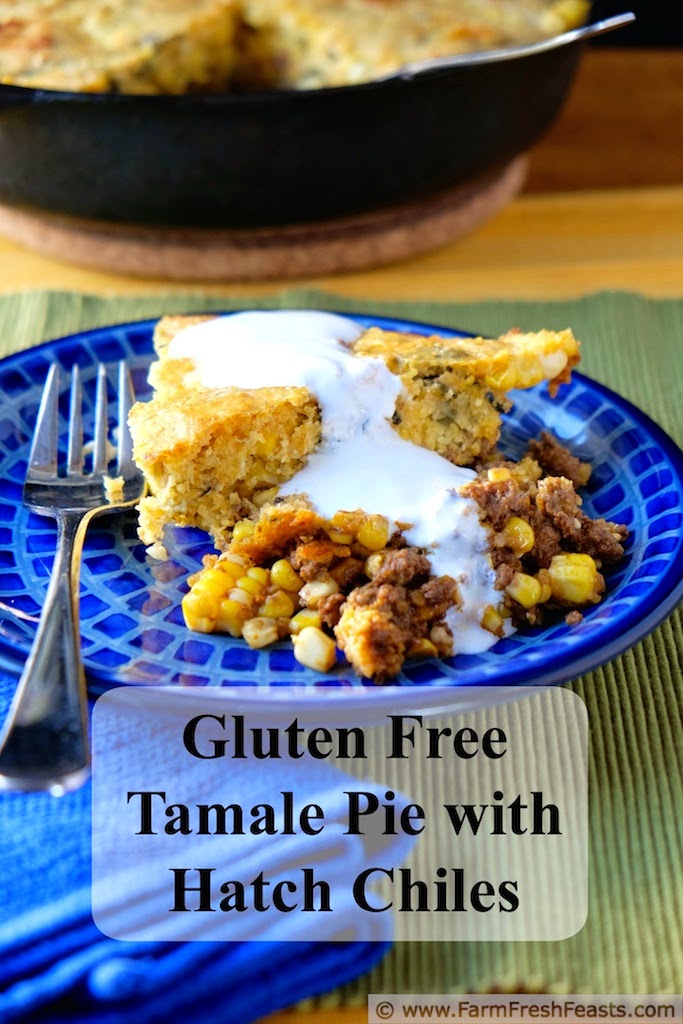
Spice it up with this beef, veggie, and cheese pie in a cornbread crust! This is another winner by FarmFreshFeasts.
Now that our tummies are satisfied, time to take a bite of something sweet!
This recipe, by Reformation Acres, makes an elegant pie in only about 15 minutes! Just put in the refrigerator for 3 hours or overnight, and you’ll have a cool, refreshing chocolate pie on a hot day. Actually, Reformation Acres has so many mouth-watering pies, you will want to browse their entire pie section.
At Pantry Paratus, we appreciate the time-tested kitchen skills of self-sufficiency, and so this dutch oven apple pie is definitely something we plan on trying! Doesn’t that pie from Montana Homesteader look just amazing?
Common Sense Homesteading gives you both a 1 crust pie recipe that you can feel good about, she also captures the flavors of late Spring! If you have some strawberries, be sure to check out her Strawberry-Raspberry Pie, too.
The Organic Kitchen gives you an amazing peach pie that will also work very well for tarts! Fresh Farm Feasts has a peach pie with a ginger-crumble topping.
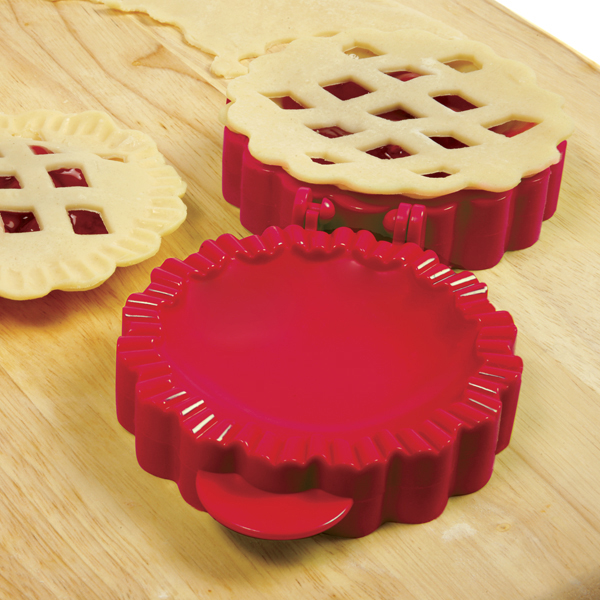 Pantry Paratus has both a set of 4 mini pie pans that comes with cute top cutters, and a lattice pie mold that will make mini pies with fewer steps. Be sure to check out all of our pie making supplies.
Pantry Paratus has both a set of 4 mini pie pans that comes with cute top cutters, and a lattice pie mold that will make mini pies with fewer steps. Be sure to check out all of our pie making supplies.
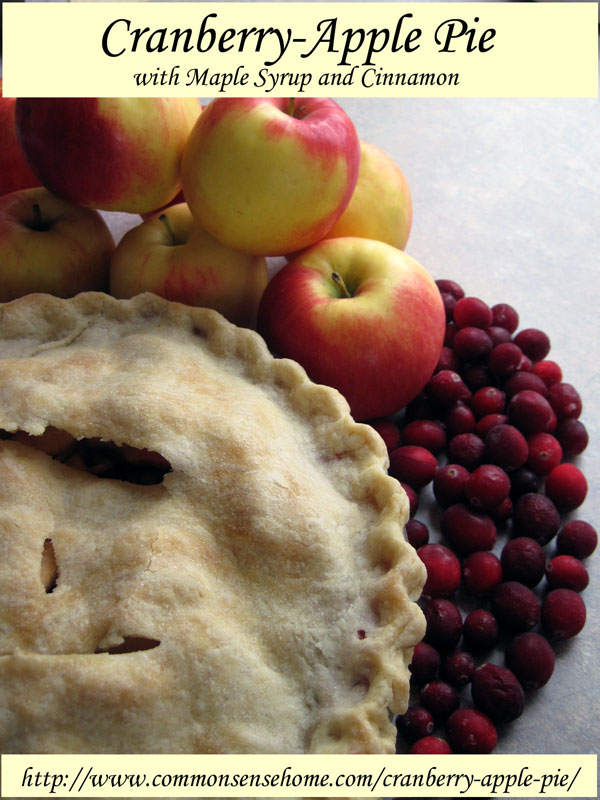
15 Minute Apple Pie a la Mode by The Organic Kitchen...amazing!
Sometimes getting the flavors of our childhood with our modern food concerns is a near-impossibility–until How We Flourish came up with this delicious apple pie recipe that everyone will enjoy together!
Raia’s Recipes brings this honey apple pie to the party with no refined sugar, no grains, no eggs, and no dairy. This is a crowd-pleaser for any crowd. Check out Raia’s rhubarb-apple pie, too!
Jessica from Natural Fertility & Wellness makes her rhubarb pie with only a handful of nourishing ingredients, making this a summertime must.
So which one will you make first? Leave your comments about these pies in the comments, we’d love to hear from you.
–Chaya
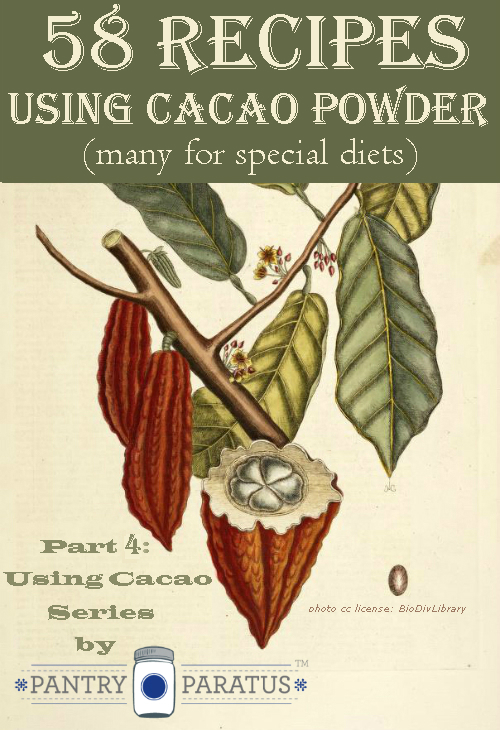
You learned how to make organic, fair trade cocoa powder from your cacao nibs. Awesome! Now what? We bring 58 gourmet recipes that range from gluten-free, grain-free, paleo, dairy-free, and just-plain-nourishing! There are even some homemade cosmetic recipes!
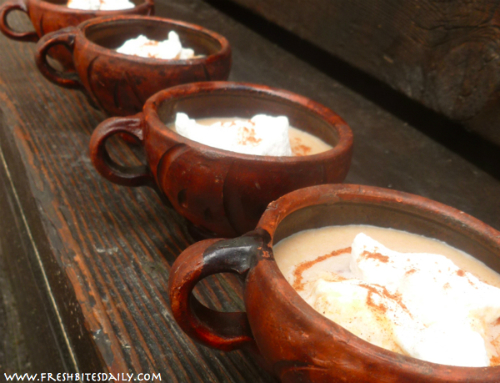
Beverages
Rainy Day Paleo Hot Chocolate (Dairy Free) by Hollywood Homestead
Honey-Sweetened Hot Chocolate by Recipes To Nourish
Avocado Banana Cacao Smoothie (Raw, Vegan) by jarOhoney
Real Chocolate Milk by Economies of Kale
Chocolate Covered Strawberry Smoothie by jarOhoney
Chocolate Banana Shake with Coconut Oil by Delicious Obsessions
Healthy Hot Chocolate by Health Extremist
Hot Cacao Drink (As Good As, Better Than? Coffee) by Fresh Bites Daily
Hot Pumpkin Spice Cacao by Fresh Bites Daily
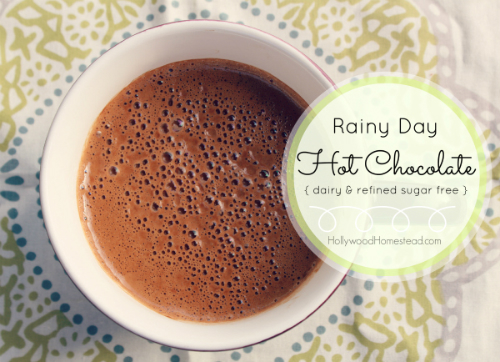
 The Kosher Cave Girl
The Kosher Cave Girl
Brownies, Cupcakes, and Cakes
Roasted Blackberry Brownies by An Organic Wife
Paleo Chocolate Pumpkin Brownies by Paleo Gone Sassy
Peanut Butter & Jelly Brownie (Vegan, gluten-free & sugar-free) by Green Press
Paleo Chocolate Cupcakes (Gluten Free & Dairy Free) by Hollywood Homestead
Gluten-Free Chocolate Mousse Cake with Cardamom by Healing, Yoga and Qigong
Hazelnut Silk Petit Four (Raw, Vegan) by jarOhoney
Real Food Chocolate Cake by The Toups Address
Super Fudgy Chocolate Walnut Brownies (Gluten Free, Grain Free) by Delicious Obsessions
Raw Brownie Bites by Live Simply
Paleo Chocolate Chip Muffins by Paleo Gone Sassy
No Bake Chocolate Fudge Fridge Cake (Raw, Vegan, Paleo) by Gourmande In The Kitchen
Grain Free Black Forest Cupcakes (& an amazing real food frosting) by The Kosher Cave Girl
Coconut Flour Brownies by Health Extremist
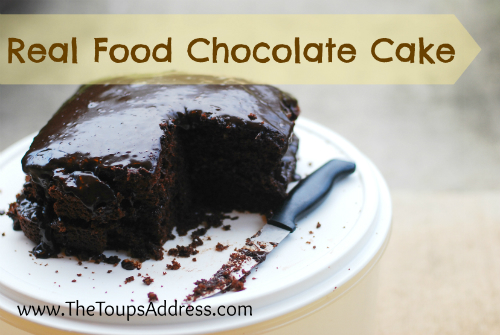
Cookies
Chocolate Nut Butter Cookies (Gluten Free, Grain Free) by Delicious Obsessions
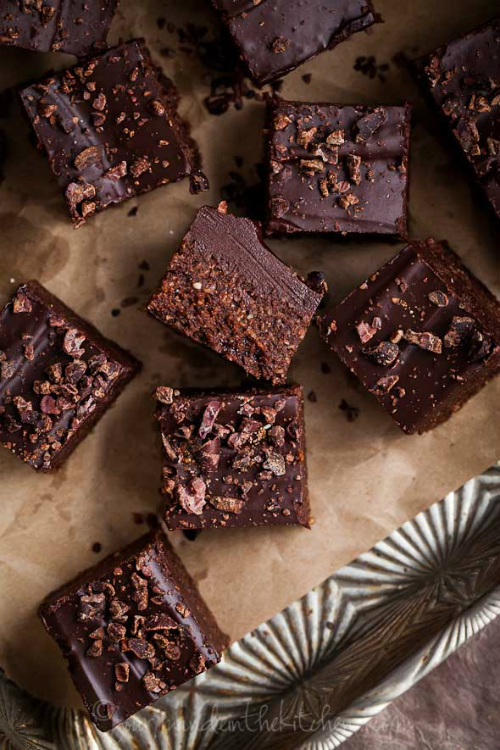
Candy, Chocolates, and Candy Bars
Raw, Healthy Fudge by An Organic Wife
Chocolate Sunflower Freezer Fudge by Recipes To Nourish
Hawthorn Herbal Chocolates by Natural Herbal Living Magazine
Chocolate Vanilla Marble Freezer Fudge by Recipes To Nourish
Homemade Candy Bars (or Chocolate Chips) by An Organic Wife
Dark Chocolate Maca Love Truffles by Happy Healthnut
Healthy Dark Chocolate Truffles by Healing, Yoga, and Qigong
Banana Bon Bons (Raw, Vegan, Paleo) by jarOhoney
Make Your Own Dark Chocolate Bar in 5 Minutes by Learning and Yearning
An Easy Homemade Chocolate Recipe by Economies of Kale
Chocolate Energy Bars (Gluten Free, Grain Free) by Delicious Obsessions
Paleo Chocolate Slice by Economies of Kale
Healthy, Chocolate Powerballs by Economies of Kale
Chocolate Almond Energy Bites by Happy Healthnut
Chocolate Peanut Butter Bon Bons by Little Owl Crunchy Momma
Chocolate Cherry Vanilla Peanut Butter Fudge Bar by Delicious Obsessions
Raw Double Layer Chocolate Fudge with Cacao Nibs by Gourmande in the Kitchen
Cacao Almond Balls by It Takes Time
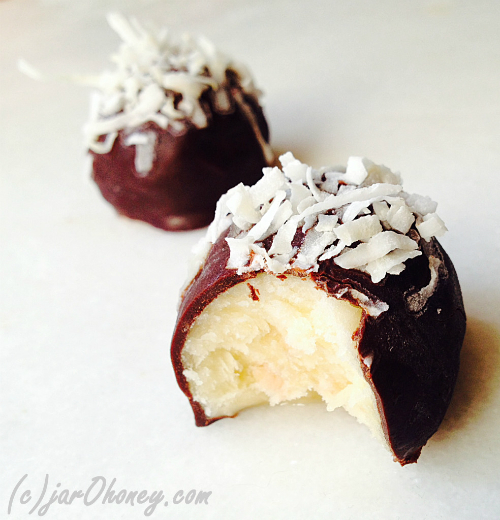
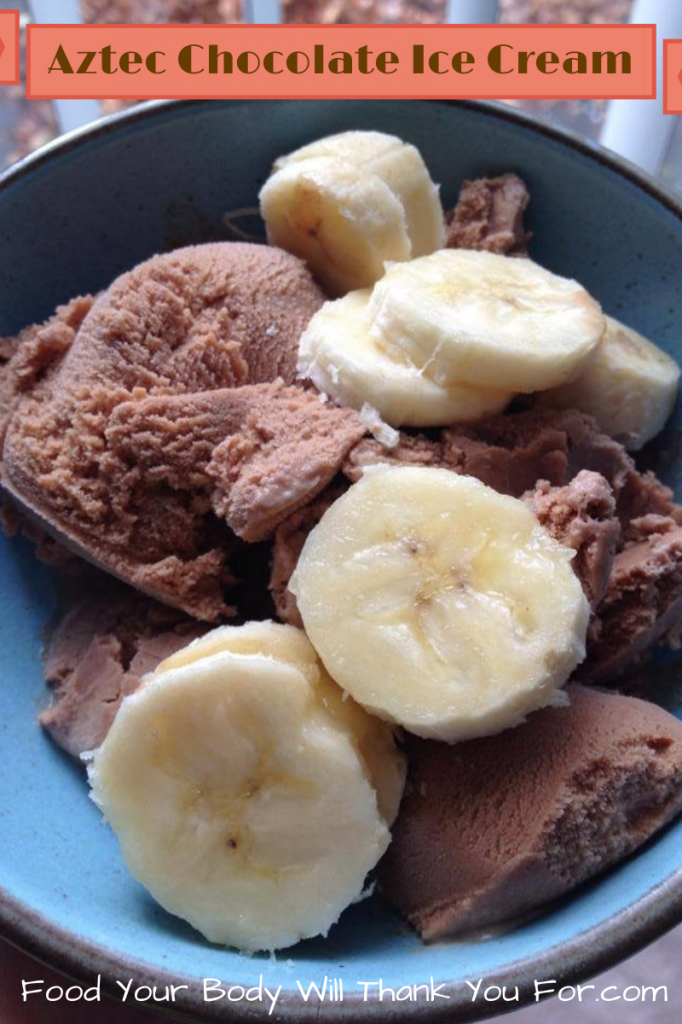
Ice Cream, Pudding
Aztec Chocolate Ice Cream by Food Your Body Will Thank You For
Dark Chocolate Chia Pudding by Family Gone Healthy
Chocolate Raspberry Avocado Pudding by Recipes To Nourish
Homemade Fudgesicles by Recipes To Nourish
Chocolate Smothered Coconut Ice Cream by jarOhoney
Old Fashioned Brown Butter Pudding (with grain free thickener) by Vintage Kids Modern World
Easy Sweet Potato Chocolate Pudding by Delicious Obsessions
Chocolate Chunk Vegan Ice Cream by Economies of Kale
Coconut Chocolate Mousse (Paleo, Primal) by Eat Play Love More
Easy, Healthy Chocolate Mousse by Economies of Kale
Maca Chocolate Pots De Crème (fertility & libido enhancing) by Real Food RN
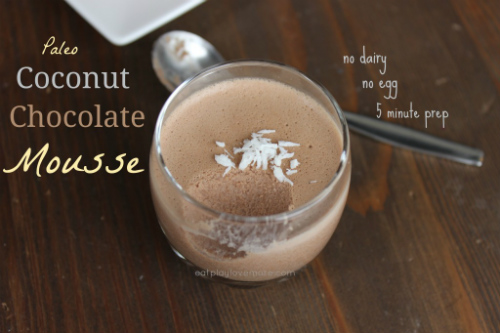
Spreads, Sauces, & Condiments
Chocolate Hazelnut Spread by An Organic Wife
Chocolate Fudge Sauce by Recipes To Nourish
Chocolate Buttercream Frosting by Recipes To Nourish
Delia’s Chocolate Syrup (Or Chocolate Sauce) Recipe by Pantry Paratus

Beauty, Cosmetics
Smooth Finish DIY Organic Foundation with Sunscreen by ScratchMommy
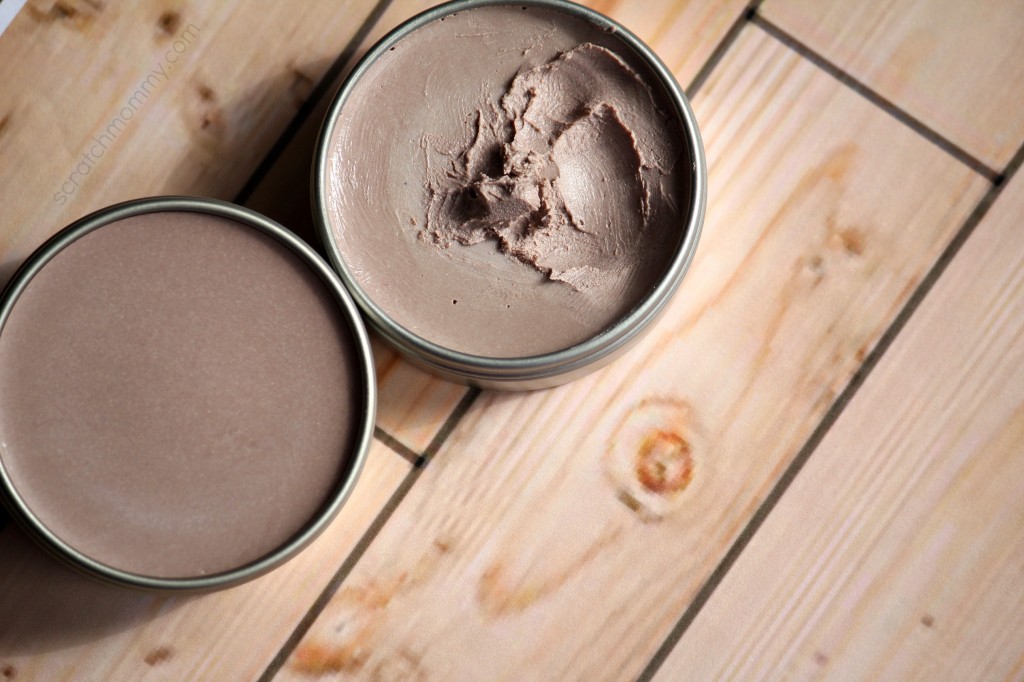
Homemade Foundation Powder by Live Simply
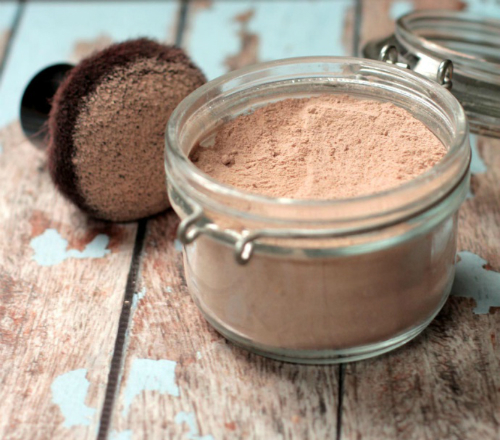
Get Organic, Free Trade Cacao Nibs Here.
Read up:
Using Cacao Part 1: Is Cocoa Powder & Cacao Powder The Same Thing?
Using Cacao Part 2: Chocolate By Any Other Name (Chocolate Defined)
Using Cacao Part 3: Homemade Cocoa Powder
Wilson’s Chocolate Series:
Chocolate Part 1: The History of Chocolate
Chocolate Part 2: The Science (And Art) of How It Is Made
Chocolate Part 3: Chocolate In America

Photos: All photos are property of the blogs for which they represent, respectively, and were used with permission. Please visit each blog’s recipe post to learn more about their recipes and photopgraphy.
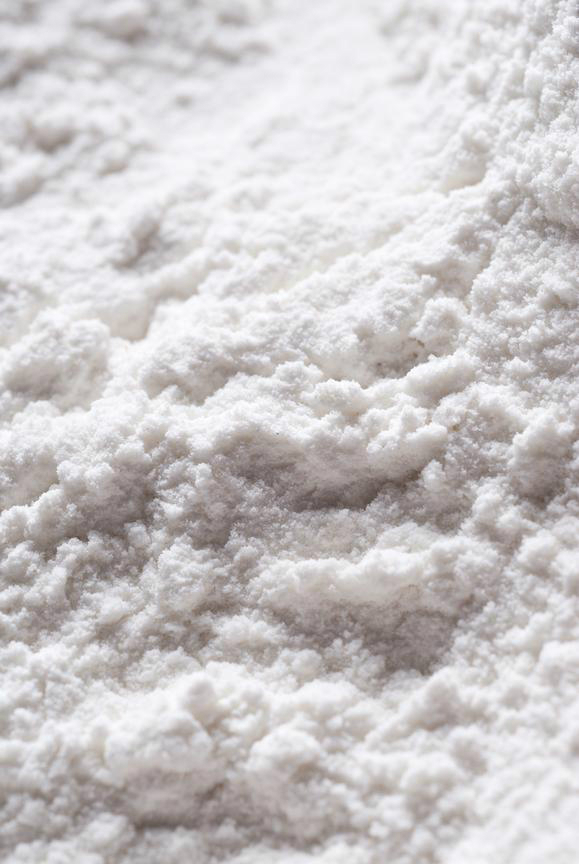

Leaven comes from the Latin word Levare to raise (M-W, 2012) and all that makes great sense, but how did Eben Horsford help? Horsford was a chemist and he knew that carbonates release carbon dioxide when they come in contact with an acid, any acid: sour milk, vinegar or even hydrochloric acid (which is not recommended). Horsford was out to find a yeast replacement that was more stable acid that could be shipped with the baking soda (sodium bicarbonate).
After years of experimenting with hundreds of acid sources in Cambridge and Germany, Horsford found that by saturating animal bones from nearby slaughterhouses in sulfuric acid, he could manufacture a crude form of monocalcium phosphate that could be dried into a powder and mixed with sodium bicarbonate to create a dry chemical leavening that fizzed when wet (Ettlinger, 2007).

“After 1854, his main preoccupation was to discover a substitute for yeast in baking bread. At the same time, Horsford entered into a business partnership with George Wilson, a former textile manufacturer, to establish the Rumford Chemical Works” (American Chemical Society, 2007). Eventually, Monocalcium Phosphate was the acid of choice and is still used to this day, although manufactured differently—just check out the Frontier’s ingredient list on this baking powder.
The story of the Rumford® is interesting:
The 1885 discovery of a sodium acid phosphate that gave off gas in response to heat, not water, led to its inclusion in the mix for a “secondary action”—the action that gave us the term “double acting.” Now, when Horsford mixed it with sodium bicarbonate, he had the first phosphate-based, stable, reliable, affordable baking powder, which he packaged as Rumford®, in honor of the great count, whose beribboned, ponytailed cameo still graces the label on cans today. . . . Rumford [sic] has the oldest consumer product label found in grocery stores, dating back to the 1860’s (Ettlinger, 2007).
Wow, that is quite a history for something you probably never gave much thought to as it was added to your buttermilk biscuits.
What is the difference between baking soda and baking powder? “Baking powder is baking soda with the acids already mixed in. That’s why baking soda is generally used in recipes that include acidic ingredients, whereas baking powder is used in recipes that contain no acidic ingredients” (Joachim & Schloss, 2008). Baking soda is baking powder minus the acids—but it turns out that the acids make all of the difference. Depending on the type of acid mixed in, the chemical leavener can be “tuned” to produce the second rising effect a certain temperature. Likewise, recipes that call for baking soda are likely doing so to counteract an acidic ingredient in the mixture (see chart below).
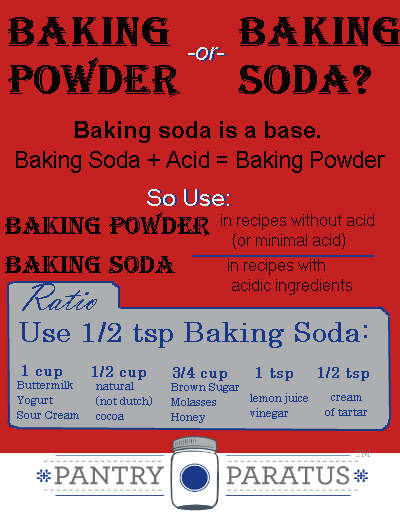
How do we get this great stuff of baker’s convenience? Rocks. Yep, it is mined from the earth. Starting off deep under Green River, Wyoming, Sodium Bicarbonate starts off as being extracted as a raw mineral called “trona” and it will produce sodium carbonate (later one more carbon atom is added to make bicarbonate). As for the Monocalcium part one needs lime, a lot of it in the food grade form—it also is mined. Lastly comes the Phosphate of Monocalcium Phosphate and it too is mined out West by mining companies such as Monsanto around Soda Springs, Idaho. The refining process is something of a wonder, and although you can find low concentrations of Phosphoric acid in a Coca-Cola® or high concentrations in naval jelly (rust stripper), phosphorus acid in its pure form will catch on fire if it contacts with oxygen—extreme care must be taken to transport it. Frontier’s Brand (which we sell in bulk) adds non-GMO cornstarch to prevent caking and you have something that we eat that (chemically) lies between glass and tracer bullets.
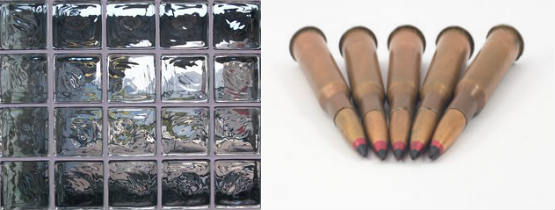
Steve Ettlinger in his fascinating book, Twinkie, Deconstructed takes you to all the places where those items are mined from the earth and then onto the southside of Chicago to a company like Innophos where they are all reacted and assembled to produce baking powder. What is interesting is that the applications for any one of those chemicals may be anything from Roundup®, to anti-acid tablets, to meth, to concrete, to paint or even paper—but the application that we are investigating is the stuff that makes a low-protein flour rise so well into birthday cake.
The next time you pull out that mason jar of baking powder from the cupboard, think of the history behind such an unassuming ingredient. While you are at it, make a Baking Certificate from Clabber Girl® (parent company to Rumford®) for any little helper in the kitchen there to do any on-the-spot taste testing.
Wilson
Pro Deo et Patria
[jigoshop_category slug=”baking-ingredients” per_page=”6″ columns=”3″ pagination=”yes”]
Works Cited:
Photo Credits:
Proviso:
Nothing in this blog constitutes medical advice. You should consult your own physician before making any dietary changes. Statements in this blog may or may not be congruent with current USDA or FDA guidance.
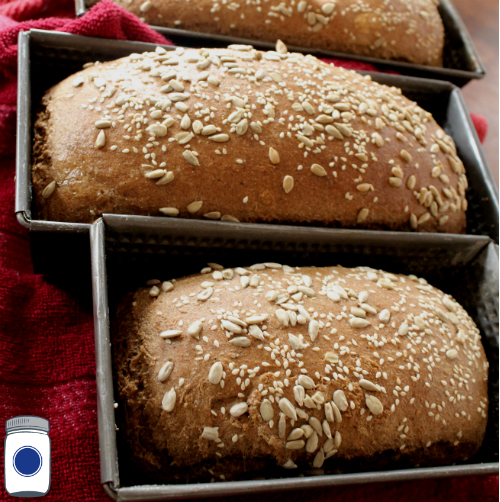
I would like to explain what each of the ingredients does and how it interacts in my bread recipe. Once you understand this, it is easy to modify a recipe and make it your own. Perhaps you avoid eggs, or want a product with less gluten, etc. If you understand the interplay of these ingredients, you can make substitutions, and create your own variant.
I prefer to start with natural ingredients as much as possible. I will mill my own flour before I get started to ensure that I have the highest nutrient density in my family’s bread. Where possible, I highly recommend pastured eggs. The Omega 3 is clear to see in the bright yellow yolks—bugs and sunshine make the best eggs! Lastly, if you can use filtered water you will get better performance with your recipe ingredients (and you will not miss the Chlorine).
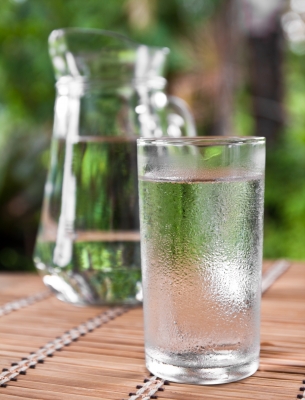
Water—Beyond joining the bread ingredients, water temperature is very important for activating yeast. You want your water to be approximately 110-155˚F. Again, filtered water is going to give the best results.
Altitude is another consideration on how much water you need to add to your recipe. Higher altitudes are dryer climates (lower boiling point for water) and will require a higher ratio of water to the dry ingredients. My recipe worked for me at both sea level in North Carolina and at 3,000 ft here in Montana . . . however I have to use a slightly higher water-to-flour ratio here at 3,000 ft. When I tried to bake bread at 7,000 ft in Colorado Springs, my low altitude recipe failed. Click here for a tested high altitude bread recipe.
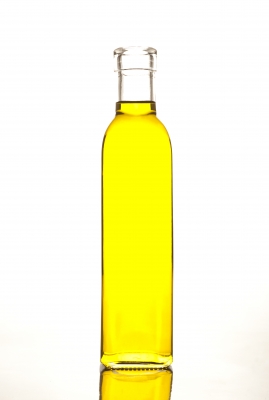
Oil—Next to flour, the quality of the oil has the most direct effect on the quality your bread, both in flavor and in nutrition. I almost exclusively use olive oil, because when you examine the finished product, you will know the recipe by ingredients used to make it. It is this fat content that makes a tender and moist baked good. The fat interacts with the strands of gluten to shorten (why we call them “shorteners”) the length of the gluten strands. This allows the gases more freedom of movement so that your baked goods are more “airy”. Egg yolks also help serve this purpose.
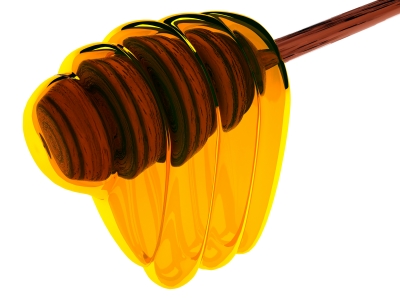
Honey—I always add the oil first so that the honey will slide out of the same measuring cup without mess or waste. Traditional cookbook recipes just use plain white sugar, which is good for plain white bread. But why, when you can take your bread from “boring” to “rich”? Honey within itself is the original antibiotic—it is extremely healthy for your immune system, it is easily digestible. Yes, it is one of the more expensive items on the ingredients list—but if you did a blind taste test between two loaves of bread, you would know which one had the honey. I have baked with a variety of sweeteners over the years, to include agave nectar, stevia, and molasses. I find that the honey has the least finicky response in the recipe and is the most versatile.
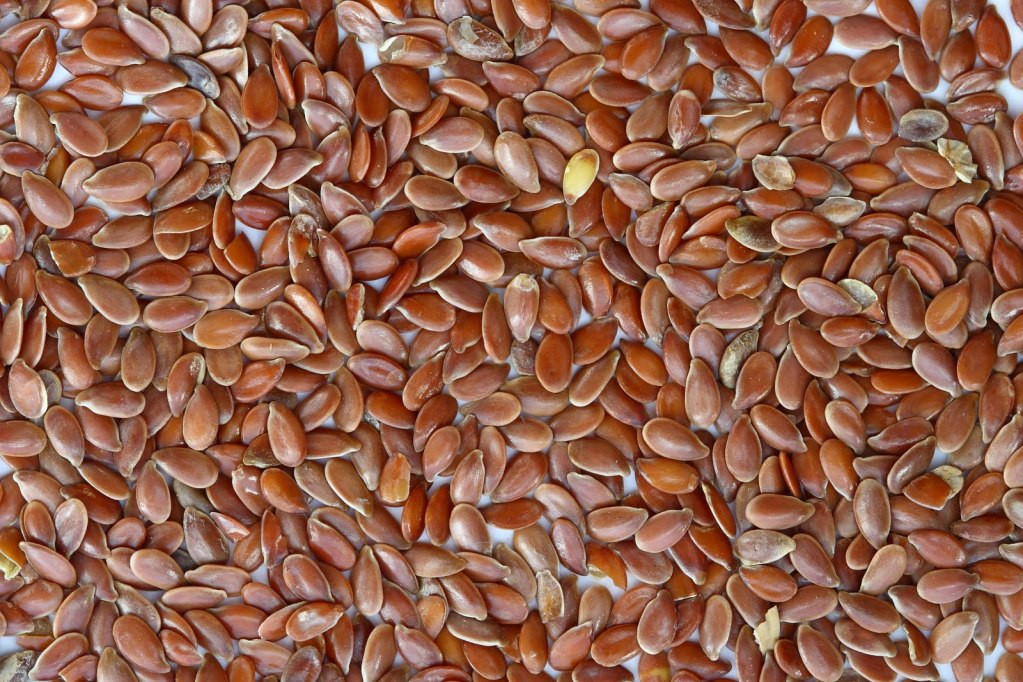
Flax Seed—this is a completely optional in my list of recipe ingredients, but one I choose for the Omega 3 fatty acids. I know that it is difficult (depending upon your geography) to fill your diet with excellent seafood. If you do not grind the flax seed, you are basically only getting the fiber and the rest of the nutrition passes through undigested. It is an excellent source of both soluble and insoluble fiber. If you grind it in a coffee grinder (you can typically pick one up cheaply for about $10.00 at a box store or pharmacy store) that you have reserved only for your herbs and seeds, you will get many precious phytochemicals in your bread. Flax, like other seed grains, has a lot of antioxidants, including lignans.
We like to use bread for sandwiches, but I commonly hear the complaint that homemade bread can crumble too much for this use. Here’s a great trick: grind your flax seed and add a tablespoon of water to it and let it sit in a bowl for a minute before adding it to your dough. It will work as a binder–just like egg–and will help hold your bread together even while giving you the great nutritional benefit of flax.
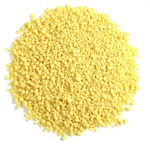
Lecithin—This one ingredient single-handedly transformed my early breads to something edible. I did not know WHY back then. Since then I have learned that it is considered a health supplement for its ability to break down fats, to improve memory, and for its promotion of healthy gall bladder functioning. It lowers cholesterol and has been linked to improving women’s reproductive health. In cooking, it is used as an emulsifier to prevent sticking (such as what you find in a cooking spray and chocolate). It provides a tenderness and (perhaps the most important thing of all), it extends the shelf life of the bread! I get several more days at room temperature out of my bread with lecithin, than the bread I have made omitting this ingredient. “Lecithin” is a generic term that can mean any emulsifier and it can be made from many sources. Although I typically avoid soy due to the GMO factor these days, I have used soy lecithin in my bread in the past. You can live without this ingredient, but its shelf life extension, texture improvement, and health benefits make this one you need to weigh personally.
Now that I’ve mentioned all the benefits and how I never baked without it in the early years, I must fess up and tell you I do not use it now. I can “read” my bread dough better with years of experience and don’t need the lecithin to help hold it together for me any more. I do have some on my shelf but I rarely reach for it now.
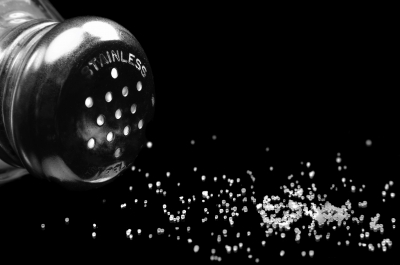
Salt—I have forgotten it more than once. Your bread is flavorless without it, entirely. I have also overdosed on it, and that makes the bread inedible at best. Salt also tempers the effect of the yeast; you usually realize you have forgotten the salt when your bread will not stop rising! Stick with sea salt if you can; it greatly enhances the flavor and nutrition of your bread. It makes it something richer.
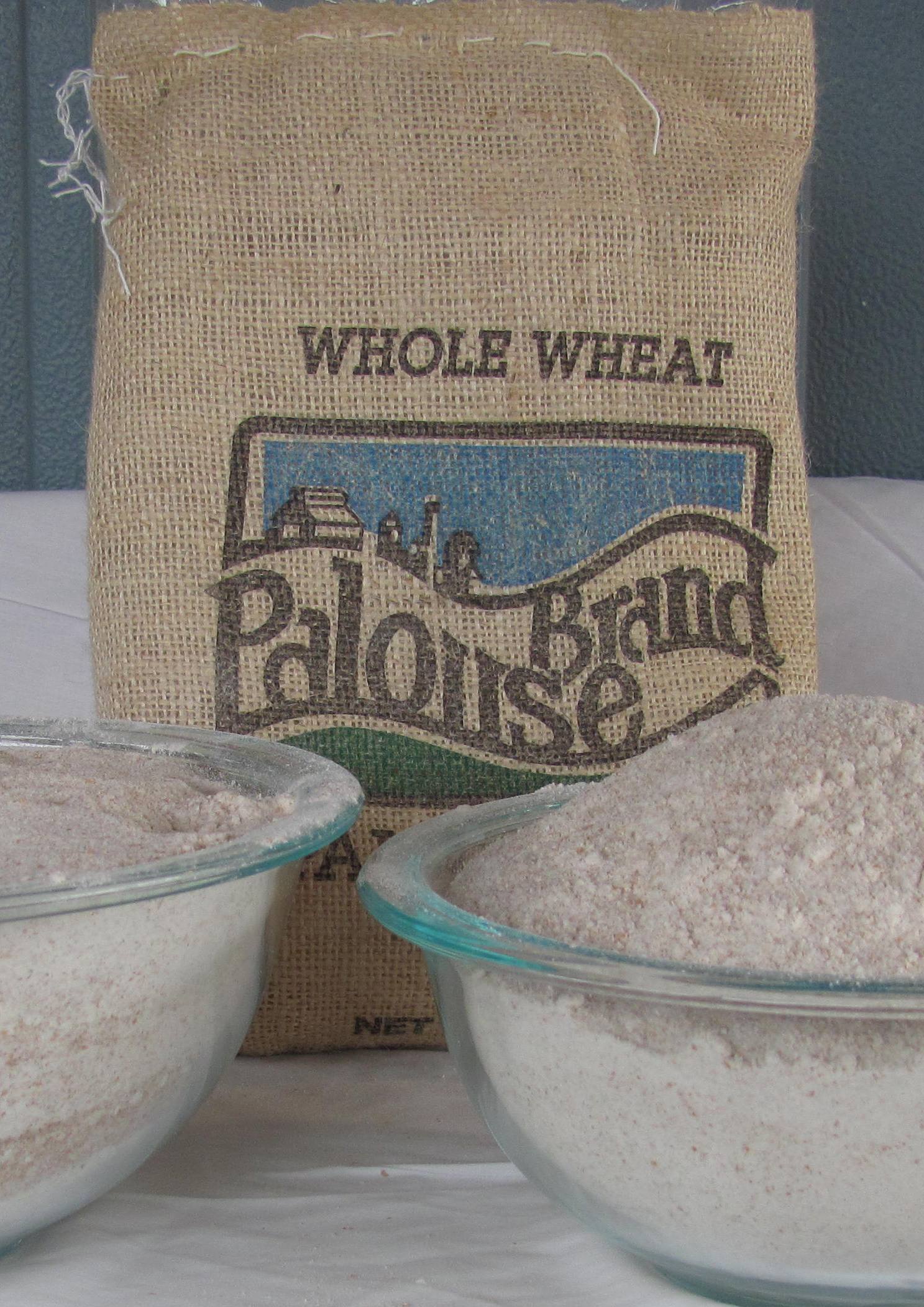
Flour—The single most important of all the ingredients, which is why I only use home-milled flours because of the marked health benefits. Store bought flours, even the gourmet ones, have had to strip some of the nutrients out in order to give it shelf life. Flours in the frozen section maintain most of the nutrition but freezer life will take its toll on that as well. Milling your own flour is easy, affordable, and the most nutrient dense way to bake bread. You can substitute bean and other flours (chickpea, for example) for some of the wheat, but do not go over 25% (you will likely need to add gluten) of the entire flour content or it will not rise properly.
Not all wheat is the same. “Hard” wheat has higher gluten and is best for yeast breads. “Soft” has lower gluten and better for lighter baking products like cake that use other rising methods, such as egg yolk, baking powder, and baking soda which also appear in quick breads.
Hard Red—this has the dark, wheaty flavor. I started with Hard White and began adding this in slowly. This can be an acquired taste, now I love it! Hard Red wheat responds very well to yeast recipe breads.
Hard White—Less wheaty flavor. Very tasty, excellent to use in yeast products.
Soft White—This is the best for quick breads, cookies, baking items with lighter structures. I sometimes mix some in with bread flours for yeast bread, but never more than 10-25% of the total flour.
Durum—This is your pasta wheat! Very tasty and you will see a difference, but in a pinch, use soft white instead.
Spelt—This is delicious and versatile wheat substitute. You can use it in both breads and quick breads. Some people who have sensitivity to wheat breads do well with this flour.
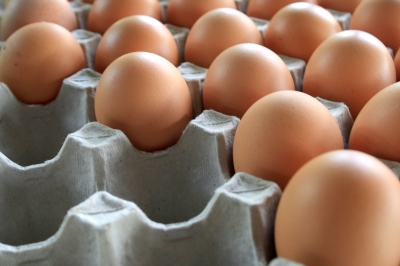
Eggs—This is the binder in your bread. I have tried to live without them and I have tasted several loaves from other bakers without it and I come to the same conclusion every time—use eggs (even better, get your own chickens)! The bread crumbles more easily without it—so if you want sandwich bread you cannot skip this step. You might want to play with how many you use. Eggs also provide another source of healthy fat for your bread, which helps lighten the overall texture.
There are likely thousands or even tens or thousands of bread recipes across the world, but each one will differ based on the ingredients. The food science is the same though, so choosing recipe ingredients that are fresh, quality and wholesome will yield a superior product. If you come across a recipe that you want to modify, you can as long as you which bread ingredients do what and why. If you come across any ingredients that I did not mention here, please leave a comment below and let me know what you like to see in your bread recipe.
Chaya
Photo Credits:
Pitcher of water http:/www.freedigitalphotos.net/images/view_photog.php?photogid=1857%22%3EImage:%20zirconicusso%20/%20FreeDigitalPhotos.net%3C/a%3E%3C/p%3E
Oil http:/www.freedigitalphotos.net/images/view_photog.php?photogid=681%22%3EImage:%20m_bartosch%20/%20FreeDigitalPhotos.net%3C/a%3E%3C/p%3E
Honey http:/www.freedigitalphotos.net/images/view_photog.php?photogid=851%22%3EImage:%20Danilo%20Rizzuti%20/%20FreeDigitalPhotos.net%3C/a%3E%3C/p%3E
Salt http:/www.freedigitalphotos.net/images/view_photog.php?photogid=345%22%3EImage:%20Carlos%20Porto%20/%20FreeDigitalPhotos.net%3C/a%3E%3C/p%3E
Eggs http:/www.freedigitalphotos.net/images/view_photog.php?photogid=1758%22%3EImage:%20Rawich%20/%20FreeDigitalPhotos.net%3C/a%3E%3C/p%3E
Proviso:
Nothing in this blog constitutes medical advice. You should consult your own physician before making any dietary changes. Statements in this blog may or may not be congruent with current USDA or FDA guidance.

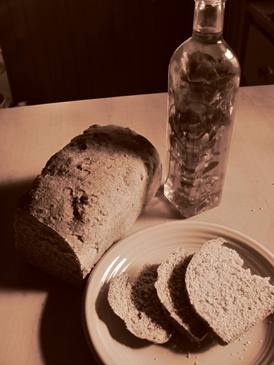
This is my personal homemade bread recipe; I hope you enjoy it. I use this dough for many purposes as it is the base for herbed breads, rolls, hamburger buns, stuffed loaves—YUM.
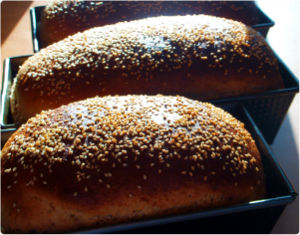
I have worked with this recipe for bread over the years and am confident with it. It also continues to evolve from time to time. Get creative, and leave a comment below telling me what you have tried and how you have modified it to fit your family’s needs. If you need a high altitude version click here.
If you avoid all soy, skip the lecithin. Use it if you want to give your bread a longer shelf life or if you have had problems with the bread being too crumbly in the past (and you had difficulty using it for sandwiches). If you want to skip the soy but troubleshoot crumbly bread, consider grinding flax seed and letting it soak in a tablespoon of water for a minute–it will serve well as a binder.
Yields: three loaves in 10’’ pans
Pull out all ingredients and have them handy to speed up the process and cut down on the mess.
I Crack my eggs into a separate bowl, stir, and let them warm to room temperature for best results.
Step 1: Add yeast to warm water (approx. 110-115 degrees) and proof to ensure the yeast is viable. Add oil and honey (oil allows the honey to pour easily from your measuring cup). Let this sit until you see bubbling yeast activity.
Step 2: Stir in flax, gluten, lecithin, salt, and eggs.
Step 3: Add flour. If you want to proof your flour (to lower the Phytic acid content) do this now by only adding 5-10 cups of the flour, stirring, and letting it sit as desired. Otherwise, add all the flour you can still stir. I recommend that you mill flour fresh for highest nutritional values.
Step 4: Oil or flour your work surface. Dump your flour out onto the table, adding the rest of the flour. Remember to oil your hands to eliminate sticking as you knead the dough.
Step 5: Knead the dough approximately 10-12 minutes (I sing through “The Lord’s Prayer” twice), or until the dough is soft to the touch, firm and yet still pliable. Avoid adding too much flour during the kneading process—it is a common mistake that can make your bread dry.
Step 6: Place the dough back into the bowl and cover. Let sit for one hour. If you have a cold kitchen, remove the trays from your Excalibur dehydrator and proof the bread in there at approximately 80°.
Step 7: Punch down your dough to release the gases. Then form into loaves with the seam down and place into the greased or floured bread pans. Lightly oil and add seeds if desired.
Step 8: Preheat your oven to 350 degrees.
Step 9: Cover your loaves again and let them sit for 15-30 minutes longer (not necessary at higher altitudes).
Step 10: Bake for approximately 30 minutes. Check for even browning and rotate if needed (every oven is different). If they brown too quickly, cover with foil for the first half of baking.
I also did a separate blog entry to give the why every ingredient appears in the wheat bread recipe, some science behind the reactions and what happens if you omit or substitute an ingredient. Bread baking is so much fun, I hope that you enjoy it as much as I do.
For best nutrition results, use a whole wheat bread recipe like this one to ensure that you are getting the healthiest results. Flour that you mill at home has superior nutrition to the dead flour that you buy on the shelf at the grocery store.
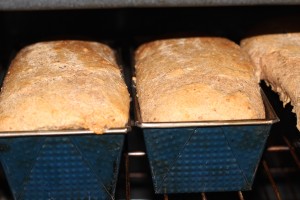
High altitude tip: I thought that I knew how to bake bread until I tried it at my best friend’s house in Colorado Springs. If your altitude is anything higher than approximately 2,000 ft, you might find you need to add more moisture to your bread dough, adjust your rise time, and adjust your cooking time. Try this high altitude bread recipe variant.
If you would like to see a video of this bread recipe, simply sign up for our news letter and you will receive a video link in your email walking you through step by step. I recently had tasted someone’s second loaf of bread (ever) that she made after watching my video-and it came out great!
If anyone modifies this specific recipe, or if you have another bread recipe altogether, please leave a comment. I would love to hear what works for you!
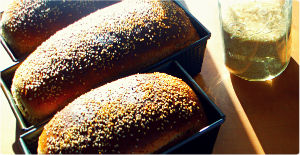
Enjoy!
Chaya
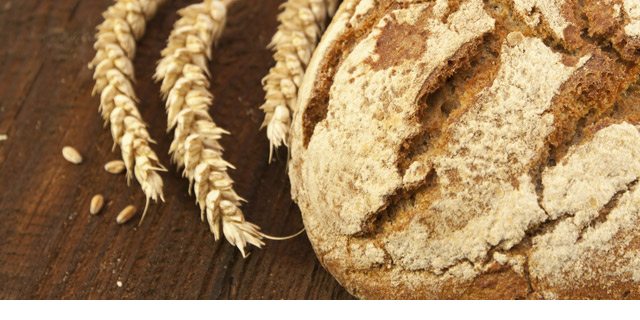
Wheat structure
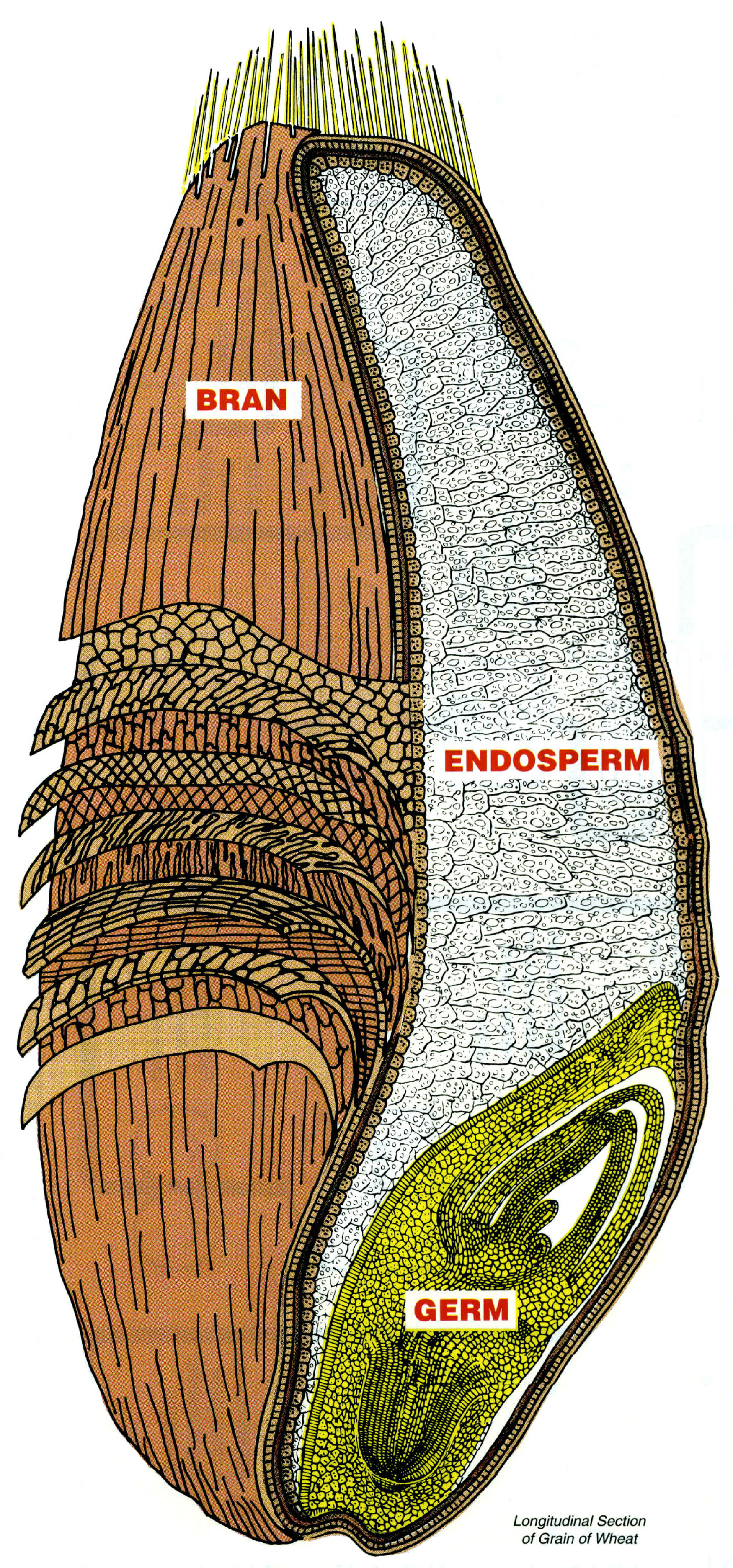
The wheat kernel (or wheat berry) has three components: the bran, the germ, and the endosperm. White flour that you purchase in the store is simply the endosperm. Actually, it would simplify so much if they called it “wheat starch” instead of “flour” so that you would know it was a kissing cousin to corn starch. The bran and germ sections have been sifted out, and are sold to you again as health supplements (or additives in healthy cereal, granola bars, salad toppings, etc.) or other value added products like animal feed. It is quite a racket: to sell the same thing to you three separate times.
The bran is the outer shell or wrapper consisting of 3 fibrous layers that protect the dormant nascent plant inside. These layers are rich in fiber and in minerals. One of these layers, the Aleurone layer, contains protein as well as high levels of vitamins and Phytic acid.
The germ is the embryo (remember, the grain is a seed of a plant), therefore it is high in both protein and fat, as well as containing the highest level of B vitamins. This is the engine inside the seed of the wheat kernel that will propel the new plant upwards. When the seed receives moisture and the plant starts to germinate, it is the germ that forms the new plant shoot.
The endosperm is all starch and protein. If the bran were to represent the fuselage and the germ the engine, the endosperm would be fuel for the new plant to start growing until it can metabolize sunlight on its own. When you buy enriched flour in the store, this what you are actually eating. It is the starch in the endosperm that contains gluten, giving baked products the composition to hold together.
A quick history of flour
The history of how white, deconstructed flour became “all the rage” is really quite fascinating. Basically, sifted flour was the European Royalty treat (think “corsets and fainting women”) and the robust peasants milled their own, hearty flours. Sifting (or boulting) has been a method employed since Roman times (they had seven grades of sifted flour). Sifting into “white” flour is nothing new, but it was never industrialized because the labor involved to go from raw wheat flour to refined sifted flour was so intensive.
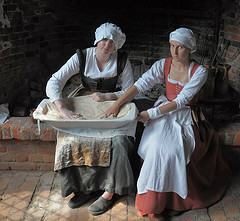
Enter the Industrial age—then an American figured out how to sift it commercially, and it became the thing in 1928. At about the same time, scientists discovered the causes of Pellagra, Scurvy and Rickets were deficiencies in niacin, vitamin C and D along with phosphorus respectively. The population at large was simply malnourished, and viola—“enrichment” became the Band-Aid® commonly practiced by 1938, and eventually the law in 1941. Flour enrichment was intended to bring ordinary flour back closer to whole wheat bread. This process is also credited with lowering the Pellagra rate from 10.5% in 1933 to only .5% by the year 1949. Even in recent history (the 2000’s), enrichment of folic acid became law and the number of babies born with neural tube defects decreased by 26%. Short version of the story, when you need to get some trace element out to the people, write a law and put it in the flour.
The Stripping and Enrichment Processes
So is whole wheat whole grain? No. It is very important understand that the greatest nutritional content of wheat is in the bran and germ, and that the endosperm—the stuff modern white bread is made of—does not contain the vitamins and minerals necessary for our daily diets. Modern day flour mills strip far more vitamins and minerals from the flour then they add back into it, and the enrichment is not sufficient to meet your body’s full dietary needs. Please do not misunderstand—adding some nutrition into dead flour has saved lives. But how many more could it save if the flour was served whole?
What is whole wheat? To answer that, please contrast the following two nutritional charts: the one on the left is for 1 serving of plain wheat berries (or kernels) and the one on the right is for a serving (1 slice) of store-bought white bread. When you compare them, understand that the 1 cup of wheat is simply 1 cup of the berries; your homemade bread, with honey, salt, liquid (potato water is full of nutritional benefits), and oil will have even higher levels.
Pure Wheat Berries: 1 serving of White Bread:
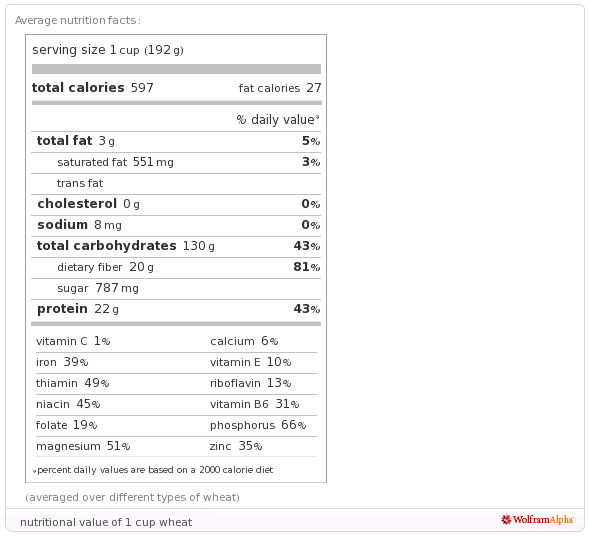
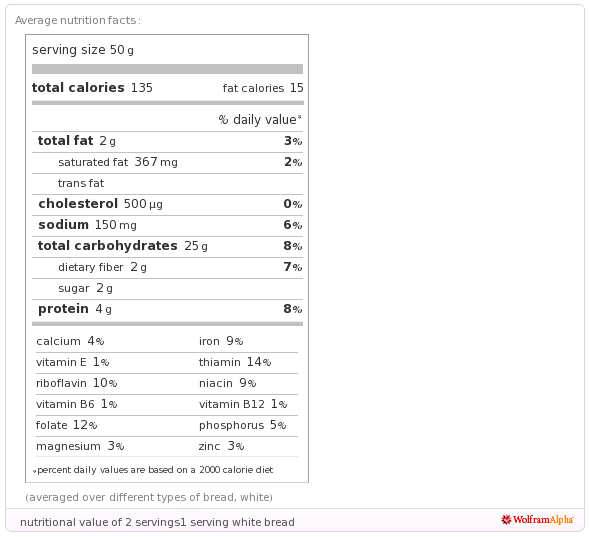
It is interesting to note that in the early 2000’s the law required the enrichment of flour with folate (folic acid). Although the quantities are different, look at the nutritional values again. Raw wheat berries and enriched bread are virtually the same amount of folic acid. There is no comparison between the fiber, iron, thiamin, niacin, magnesium, vitamin B6, phosphorus, and zinc!
There is something unique about the iron level differences between the raw and the processed. Anemia is the most widespread vitamin deficiency in the world, irrespective of the financial health of the countries. The white bread has been enriched with iron and cannot compare to the natural iron levels found within the wheat. Since there is more than one type of iron, and because the type naturally found within wheat oxidizes quickly, the enrichment process will insert a form less easily digestible than the one that comes integral to your wheat kernel. Actually, the iron in enriched flour “usually begins not only in iron ore mines in Minnesota, which is no surprise, but also in oil wells, which is” (Ettlinger, 2007). Ettlinger goes on to point out in hilarious detail that the ferrous sulphate (iron substitute) in enriched flour actually is derived from crude oil (sulphur) and the rust residue in acid pickling tanks from steel mills production lines (ferrous).
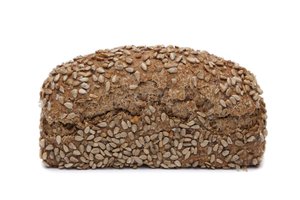
If flour mills take far more out than they put back in through enrichment—so why take it out at all? The reason is shelf stability. True whole wheat flour (flour made from all three parts of the wheat kernel) will quickly oxidize and go rancid. Actually, the nutritive value of the fresh ground whole wheat flour plummets in mere hours after it is ground (although the process can be stalled significantly if the whole wheat flour is immediately put into the freezer).
When flour mills strip the whole wheat grain of its bran and germ, they are taking more than the vitamins that you see on the label; they are stripping phytonutrients. Also called “phytochemicals,” these are plant nutrients that are not considered essential. That just means that they enhance your life but might not be essential to it. For instance, studies suggest that one such phytonutrient, Lignans, can guard against breast and prostate cancers (Mathis, 2005). These may not make a label, but they are crucial for quality of life.
“Let your food be your medicine and your medicine be your food” -Hippocrates.
To get quantity, there must be a bulk filler (typically starch) that is used to add nutrients back into the flour for enrichment. Remember that starch consists of high levels of glucose, and this turns quickly into a “sugar” in your body. So the enrichment process is not without the unfortunate side effect of making bread products “starchy” and a poor choice for diabetics. True living bread is not this way. The natural starches contained within the wheat are counterbalanced by the naturally occurring vitamins, minerals, fiber, and protein.
Vitamin E—The original miracle drug
Vitamin E is a fat soluble antioxidant. That means that they protect cells from harm done by damaging free radicals, which are molecules that contain an unshared electron (Office of Dietary Supplements, 2011). The Ohio State University measured the amount of vitamin E in various foods, to include oils. The highest item on the list was 1 tablespoon of wheat germ oil, just the oil! That one tablespoon provides 20.3 milligrams of vitamin E—that’s 135.3% of your RDA! There is no greater known source of Vitamin E in the world than in whole wheat (Mosure, 2004).
Phosphorus
Phosphorus along with Vitamin D are needed in healthy diets to fight Rickets (a disease where the bones degenerate and soften). Phosphorus is represented in adequate quantities in enough unprocessed foods so that deficiencies are only a concern in people who routinely consume antacids or who have a disease in the kidneys. Whole wheat is perhaps the second best common source for phosphorus you can find—the highest value going to the yeast used in bread baking. With the advent of enriched flour, the tracer bullet manufacturing sector has had to share its primary ingredient (Phosphorus) with bakers. Hmmmm, I think I will just stick to whole wheat home ground flour.
Conclusion
Let’s consider eating God’s bounty as He designed. We could discuss the various vitamins, minerals, and phytonutrients of whole wheat for many pages more; this is not an exhaustive list of the health benefits to this fundamental grain. Rather, it is a brief highlight of the value of this often underated food staple. Please consider replacing the deconstructed flour in your diet with true whole grain. Flour milling is as simple in modern times as flipping the switch on any kitchen appliance. The lingering scent of freshly baked bread, the indulgence of a warm slice from the oven, the improvement in skin, digestion, and overall health—this is a wonderful gift to yourself and to your family.
Chaya
Photo Credits:
Wheat kernel cutaway from the Montana Wheat and Barley Committee: http://wbc.agr.mt.gov/wbc/Consumer/Diagram_kernel/
Boulting Flour in the Bakehouse by Kentwell Hall Great Re-Creation, June 2010 (Depicting 1538) http://www.flickriver.com/photos/nigesphotobox/4741585459/
Bread by Viererie http://www.rgbstock.com/photo/nfAVg1Y/BreadBread
Works Cited:
Ettlinger, S. (2007). Twinkie, deconstructed, my journey to discover how the ingredients found in processed foods are grown, mined (yes, mined), and manipulated into what America eats. (First printing, March 2007 ed., Vol. 1, p. 32). London: Hudson st Pr.
Mathis MD, C. (2005, April 01). Web md. Retrieved from http://www.webmd.com/diet/phytonutrients-faq
Mosure, J. (2004, November). The Ohio State University Extension Office Online. Retrieved from http://ohioline.osu.edu/hyg-fact/5000/pdf/5554.pdf
Office of dietary supplements. (2011, October 11). Retrieved from http://ods.od.nih.gov/factsheets/VitaminE-HealthProfessional/
For further study:
http://www.drcranton.com/nutrition/bread.htm (highly recommended reading)
www.americanbakers.org, “Celebrating 70 years of Enrichment”
http://cuny.edu/archive/cc/health-in-america/nutrition.html
www.wolframalpha.com for the nutritional charts
http://www.mostproject.org/PDF/2.pdf US Aid, “Manual for Wheat Flour Fortification with Iron”
http://www.webmd.com/diet/phytonutrients-faq
http://www.lesliebeck.com/ingredient_index.php?featured_food=120 Leslie Beck, RD; “Wheat berries – March 2010’s Featured Food”
http://www.sph.emory.edu/wheatflour/KEYDOCS/MI_Fort_handbook.pdf Wesley and Ranum, eds. “The Fortification Handbook” (2004).
http://ohioline.osu.edu/hyg-fact/5000/5554.html Vitamin E: Ohio State University Extension Fact Sheet
http://ods.od.nih.gov/factsheets/vitamine/ Office of Dietary Supplements, National Institutes of Health. Dietary Supplement Fact Sheet: Vitamin E
Proviso:
Nothing in this blog constitutes medical advice. You should consult your own physician before making any dietary changes. Statements in this blog may or may not be congruent with current USDA or FDA guidance.
posted on Monday, October 6, 2014 9:49:08 AM America/Denver
posted on Wednesday, October 8, 2014 1:11:34 AM America/Denver
posted on Monday, October 13, 2014 10:09:19 PM America/Denver
Hi Chaya, thank you so much for a wonderfully researched and insightful article!!! Two small things, you have “viola” up by/underneath the women sifting flour which is meant to be “voila.” I have done this myself and am always glad someone lets me know; so I hope you will not mind. Secondly, I think it would be helpful if you mention sourdough or sprouting, since the nutrients are much more accessible and historically-based as far as procedures and nutrition when the grain is predigested. Thanks, kindly, Megan 🙂
Thank you for catching that! I’ll change it right away; I want to get attribution correctly. You would enjoy this blog about Phytic Acid, in which I talk about there very thing! It would have made a good addition to this blog, agreed. It’s hard to fit so much science into a readable blog! Glad you liked the article.
posted on Wednesday, October 15, 2014 7:11:47 PM America/Denver
Why do I even mention that? Because the author seems to have an axe to grind with faith and the Bible/Christianity in particular–which is altogether fine by me. My problem is that if I was anti-vegetarianism, I would not go take a shot at Seventh Day Adventists straw-man to gain traction on my argument. If following the evidence where ever it leads gets him to be upset with the nativity scene, then I think that my bias detector is correct when I see that as irrelevant to the topic at hand.
Back to wheat, yes, if he is correct, we eat a lesser form of wheat. By way of comparison, Chaya and I used to own a Boxer named Dallas. She was a GREAT dog, very affectionate, loyal, athletic and quite the clown. She was a Boxer; she was not a wolf. All dogs descended from wolves, she was a wolf-minus if you will, but we got all of the canine we needed in that lovable package. The point is to show a diminished modern product does not mean that what we have is somehow needs to be discarded because it is not pure. Sure, I would love to eat 42 chromosome wheat, and hopefully the author can bring the strain back to vogue and we can compare the data. But for now, the wheat we eat is very good, high in protein in Vitamin E.
To be clear, when I say “wheat” (as in what we eat at our house), we start out with a wheat berry/kernel and then grind that into flour. That wheat is superior to the bagels stacked as cover art of dead white flour that had to be enriched by law to avoid vitamin deficiencies like beriberi and rickets. In that the author and I are in agreement, that is not wheat, that is wheat starch-minus.
Thanks for the comment!
Wilson
posted on Thursday, October 16, 2014 4:39:50 PM America/Denver
Becky
posted on Saturday, June 14, 2014 10:07:40 PM America/Denver